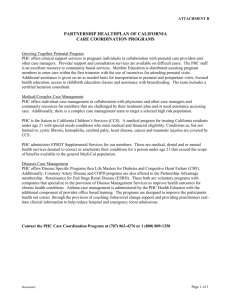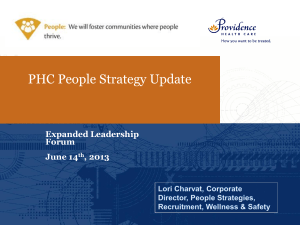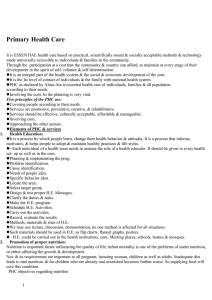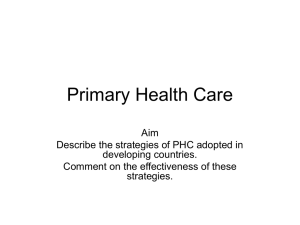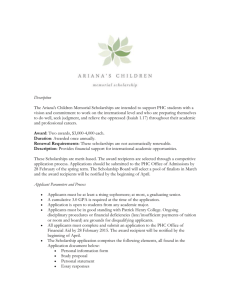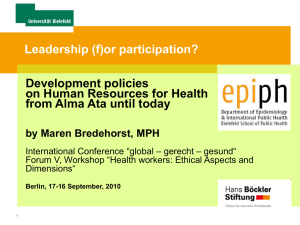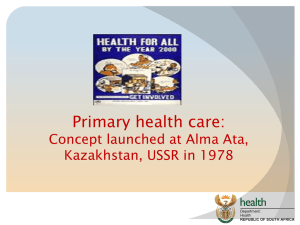Primary health care concepts
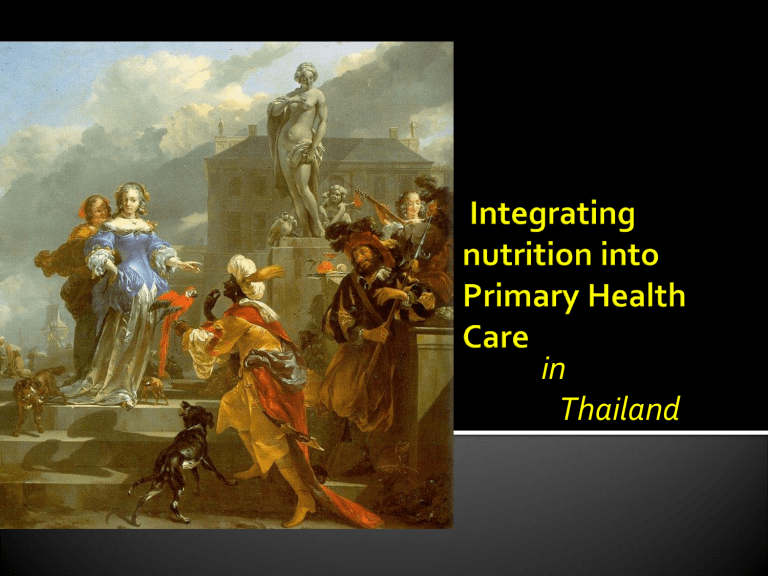
in
Thailand
The Thai PHC is based upon local culture and tradition
.
Traditionally, health care was a family responsibility.
Our PHC attempts to utilize local manpower and technology to the fullest extent.
Village Health Volunteer (VHV) is a home-grown concept.
True to the word, VHV has no salary, only free medical care and other possibility of support from Government
(e.g.contract to develop community-based programs etc.)
To be effective, the ratio of volunteer to household must be adequate.
In our case, we use a ratio of 1 : 15, based on natural communication network within a community.
Hence, the number of health volunteers ranges between 10 – 15 in any given village ( 800,000+ in all).
Community-based program needs enough village manpower to run.
In a community context, adequate number of manpower leads to better decision-making and coverage is more complete.
Community behavioral change needs a critical number of b) converts to become effective.
At least 3 groups should be organized and defined i.e.: a) health volunteer ( to employ certain skills) interest group (intended as change agent) c) target group (must be well-defined)
Build up critical mass by creating common vision or goal to which everyone adheres .
The health worker, working with the people, must be prepared to convince them of their problems. The tactic is to invite them to do their own survey, impart upon them simple planning technology then let them make their own choice.
Never force one’s own idea upon the people.
In the PHC context, people make their own decision and initiate. If they are not ready, no order can be given. The health worker plays a facilitator role.
The most common fallacy is the belief among health workers that volunteers are created to alleviate their work, thus they (volunteer )are regarded as subordinates.
Volunteers work for their fellow villagers, not for the health worker.
Health workers never substitute for what people can do for themselves.
PHC was derived from the concept of cost-effectiveness,as such:
1.
Refinement of the target group is key to better efficiency.
Under-privileged families must be identified,accessed and
2.
taken care of.
Efficiency is dictated by pattern of manpower deployment.
Matching of level of skill of manpower with severity of problem is essential . Example:The use of volunteers to take care of simple health and environmental problems.
3.
As a consequence, program for screening and referral of cases must be put in place (through health insurance scheme in our case) ( continued)
4.
Community manpower can be trained to become proficient in every aspect of PHC
Real problem remains with the attitude and acceptance of the health worker.
5. Major hurdle to overcome is inter-sectoral collaboration.
In our case, we use the Basic Minimum Need
6.
approach. All government agencies use the same set of indicators for Quality of life which is multi-dimensional.
Community involvement goes hand-in-hand with degree of decentralization ( decision-making and budgeting )
Here, national policy has a role to play .
Choice has to be made between
1. Application of PHC concept into nutrition intervention activities or
2. Integration of nutrition intervention activities into
PHC program.
why ?
Which choice should bring about better results and
Stage of development of nutrition vis-a’-vis PHC program.
Coverage of the target groups ( 3 degrees of PEM ).
Main intervention measures to be applied ( surveillance, supplementation, education etc.).
Collateral health development activities ( sanitation, CDC control, medical care, IEC, health system reform etc.)
Policy and strategy concerning development approach.
Decentralization and budgeting policy.
In our case, we opt for the integration of nutrition into PHC.
1.
2.
3.
Weighing of children should be done by VHV with the help of mothers. Primary objective of the activity is to make them realize that the problem exists. Accuracy of measurement is secondary in importance.
If the mother is convinced, she becomes more receptive to advice and tends to act with or without external help.
Normally, redistribution of nutritious foods toward the child will happen within the family.
This phenomenon generally affects the decrease of first degree PEM, while those with second degree may need extra supplementation and third degree medical attention.
(continued)
4. Make wise choice among 4 intervention measures
4.1 Increase food production and nutrition education.
4.2 Food supplementation.
4.3 Food fortification
4.4 Direct treatment.
Each has its own benefits and drawbacks.
Priority for consideration remains in the above order.
5. Choice and acceptance of food supplement by the people is paramount. Technical aspect comes after choice is made, not the other way around.
6.
7.
8.
Choice must be made between development or welfare approach. Technically, development approach is preferable, but politically, welfare approach stands a better chance of acceptance and support.
Choice must be made between organizing new vertical program or upgrading existing health service system and programs. If decision is to integrate nutrition into PHC, then vertical program is out of question.
We never had success with fortification programs carried out in its own sake. This confirms the fact that nutrition problem is multi-dimensional which needs a combination of measures.
According to people-centered development concept,
chance of success rests upon people “ playing right role.”
The 3 major roles that people must play:
1. self-care.
2. Care of various aspects of environment.
3. Involvement in community programs.
What are factors which influence their decision to play such roles?
1.
2.
3.
4.
5.
6.
7.
Skill development
Analysis and acknowledgement of problem.
Right information and personal experience.
Networking of similar-interest individuals and groups.
Appropriate support systems (planning,organization, finance, coordination, supervision etc.)
Leadership development.
Strengthened spiritual aspect
(trust,confidence,consciousness,faith, community-spirit etc.)
Effective process to address above factors will contribute to the success of community-based nutrition/PHC program.
5.
6.
7.
1.
2.
3.
4.
Build up conscience and confidence to make changes in life.
Provide appropriate setting for learning experience.
Basic need fulfillment ( food, housing and environment, CDC, medical care etc.)
Involvement in social activities(health campaigns, conservation etc.)
Promote spiritual uplift activities ( religious practices, meditation, rest and recreation, exercise etc)
Promote better lifestyle.
Promote right concept and vision, leadership.

